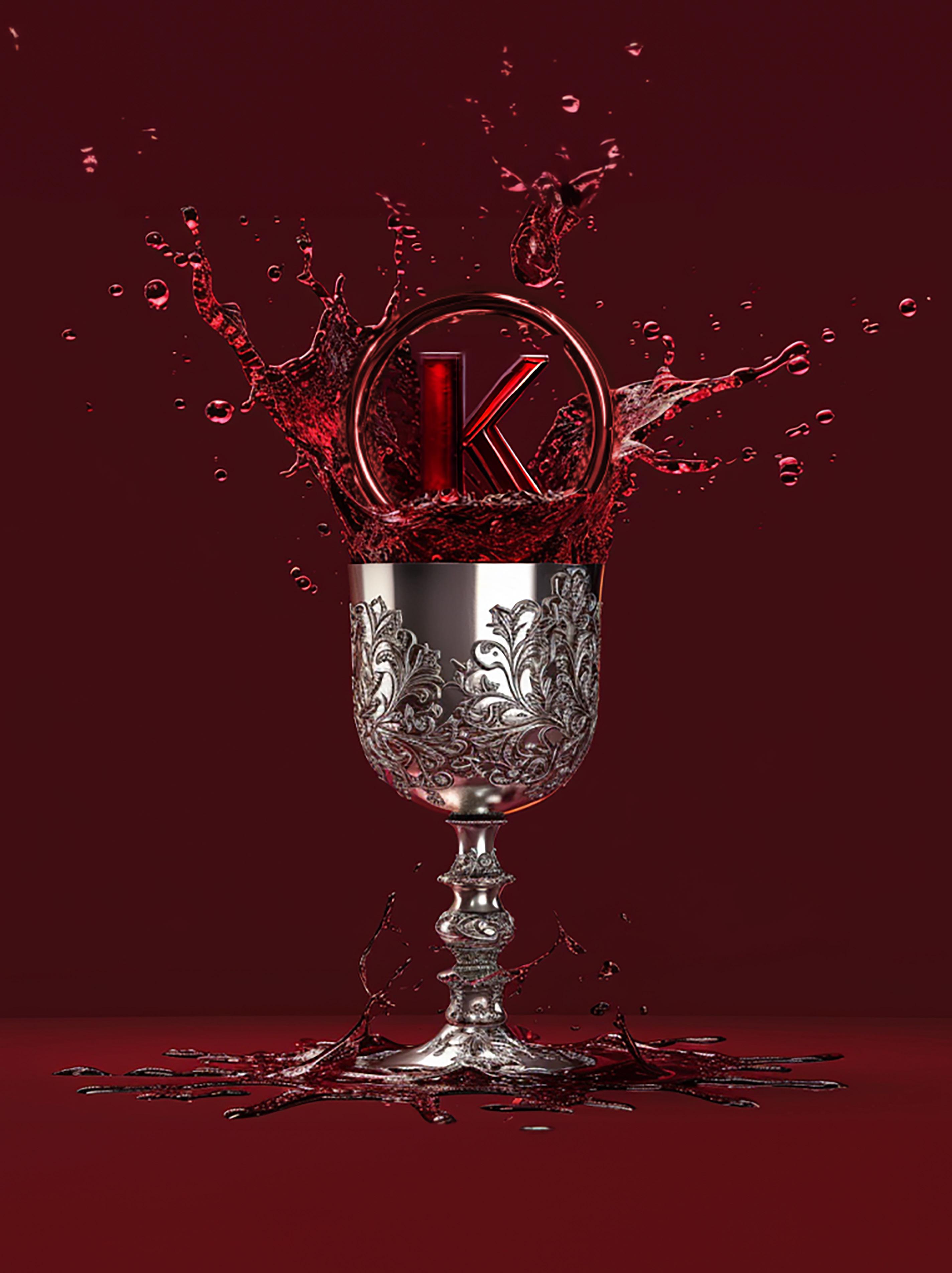
WISHING
CERTIFIED SOUL NUTRITION
YOU
5784 ד”סב ד”פשת ןסינ חספ ןכעליירפ ןוא רשכ א
A HAPPY PESACH! NISSAN

RABBI


Dear Reader,
As our brothers and sisters in Eretz Yisroel continue to fight for our right to exist and protect our nation, I took a trip to the Holy Land to give encouragement and support to our brave soldiers and to check in on our Rabbinic Coordinators and mashgichim, who continue to do whatever it takes to ensure the kashrus of the products we certify.
I met with soldiers on an Air Force base who were filled with enthusiasm and high spirits. I met with ~ Rabbinic Coordinators coordinators who are traveling across the country and beyond to make inspections and kosher productions. I met the rabbis of Tzahal responsible for kosher food in the army. They spoke of their efforts to elevate the level of kosher for the entire army as a zechus for the soldiers fighting for Eretz Yisroel. I shared with them that this is in line with the portion of Tanya that explains that non-kosher food can never be completely elevated, even when performing mitzvos with the energy one got from the food. Kosher food, on the other hand, permanently elevates the body and soul.

I met with Rabbonim responsible for all the kosher food that enters Israel. And sadly, I met with families, women, and children who were forced to evacuate their homes for safer locales. I visited factories that are low on staff because their workforce is serving in the army reserves. I met with young people who were wounded but were so grateful to be alive. I met people with smiling faces, who were simply happy that we came to Israel. I met people who just keep moving forward, one step at a time. I met with a nation filled with love for each other and in high spirits. I met an incredible country filled with Hashem’s children who know the difference between good and evil, right and wrong.
As we get ready to celebrate the holiday of Pesach, the holiday of freedom, may Hashem bless our soldiers and our wounded, may we see our hostages come home, and may we all be blessed with peace and true freedom with the coming of Moshiach now.
With best wishes for a kosher and freilichen Pesach, Rabbi Chaim Fogelman Editor in Chief, ~ Executive Kashrus Vaad
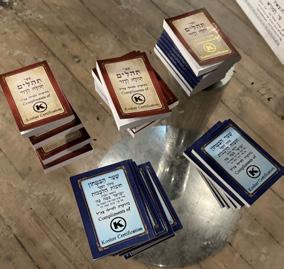
BEREL LEVY OB"M and RABBI DON YOEL LEVY OB"M, who set the standards of kashrus at ~ Kosher Certification and who inspire us daily to perpetuate and uphold their legacy. is dedicated to
photo credit:
KOSHER SPIRIT Pesach 5784 EDITOR-IN-CHIEF: Rabbi Chaim Fogelman EDITOR: Dina Fraenkel DESIGN: Spotlight Design We welcome your comments, submissions and letters to the editor. Mail: 391 Troy Avenue, Brooklyn, NY 11213 Email: editor@kosherspirit.com © 2024. No portion of this publication may be reprinted without written consent from the publisher. 3 WHAT’S THE BROCHA? DILUTED WINE By Rabbi Sholom Ber Lepkivker 4 HEALTHY SPIRIT Your guide to seasonal spring produce 5 PESACH RECIPE: FLANKEN 6 HALACHA B’IYUN: PESACH By Rabbi Shlomo Weinfeld 9 YOSHON Q&A by Rabbi Yakov Teichman 12 IS CULTURED MEAT KOSHER? By Rabbi Sholom Kesselman 16 REMEMBERING RABBI AND MRS. LEVY 18 BRAZIL: A JOURNEY FOR KASHRUS 20 A CLOSER LOOK: POTATOES by Rabbi Sholom Ber Hendel 22 CHASSIDIC INSIGHTS: MATZAH 23 SOUL NUTRITION by Rabbi Chaim Fogelman
Marko Dashev
Dinner and Sefarim for the Chayalim

What’s the Brocha?
Diluted Wine
 By Rabbi Sholom Ber Lepkivker ~ Rabbinic Coordinator
By Rabbi Sholom Ber Lepkivker ~ Rabbinic Coordinator
wine is among the most important drinks in Jewish life, especially on Pesach. The posuk says that wine yisamach levav enosh (it makes the heart rejoice) and we are commanded to drink wine to sanctify Shabbos and Yom Tov, consecrate a marriage, and as part of a bris milah, etc. Wine plays a central role at the Pesach Seder, symbolizing the four descriptions of geulah mentioned in the Torah1 , and it is essential to know the laws of the brocha on wine.
Since wine is made from grapes, the brocha should have been borei pri ha’eitz2 ; however, due to its importance, the Chachamim gave it a special brocha, borei pri hagafen
If, for whatever reason, the wine is too strong to drink, one cannot make the brocha of borei pri hagafen, until the wine is diluted with water or another liquid to make it fit for consumption. If the added liquid becomes the majority of the mixture, the brocha should be made on the added liquid (shehakol)
If the taste of the wine is negatively impacted by the addition of a liquid other than water3 , even if the wine is still the majority of the mixture, the brocha becomes shehakol.
Water, due to its neutral taste, does not negate the brocha of borei
1 Among other reasons.
2
3
4
pri hagafen unless there are three parts water to one part wine in the mixture. If less water is added, but the wine becomes weak and loses its taste the brocha becomes shehakol. Though ~ certified wines aren’t diluted with water, some hechsherim permit dilution. Therefore, it is best not to dilute wine with water or other liquid.
When determining the brocha, the taste of the wine is the deciding factor. Even if the wine smells like vinegar, if it still tastes like wine, the brocha is borei pri hagafen4 .
If one needs to dilute their wine for kiddush or the Seder, it is best to consult with a Rav for specific instructions. ~
'ב 'א נ"הכרבס
'ו 'ז נ"הכרבס
'ד םש
www.KosherSpirit.com 3
High in vitamin C, iron and vitamin K. Makes a great snack
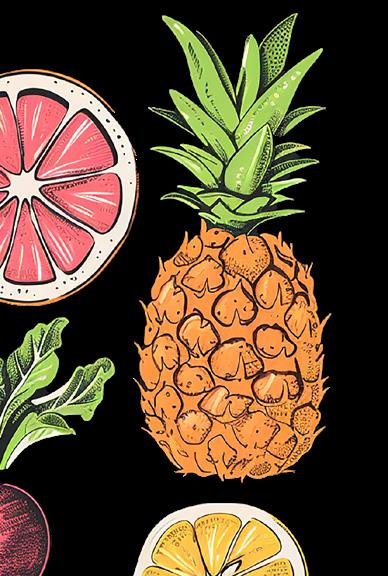
Pineapple
Has anti-inflammatory and pain-relieving prop erties and vitamin C. Great for breakfast, snack, or dessert.

Snap Peas Carrots
Rich in vitamin C, beta carotene, folate, potassium, magnesium, and iron. Boil to soften and use in salads, or roast with other root veggies for a delicious side dish.
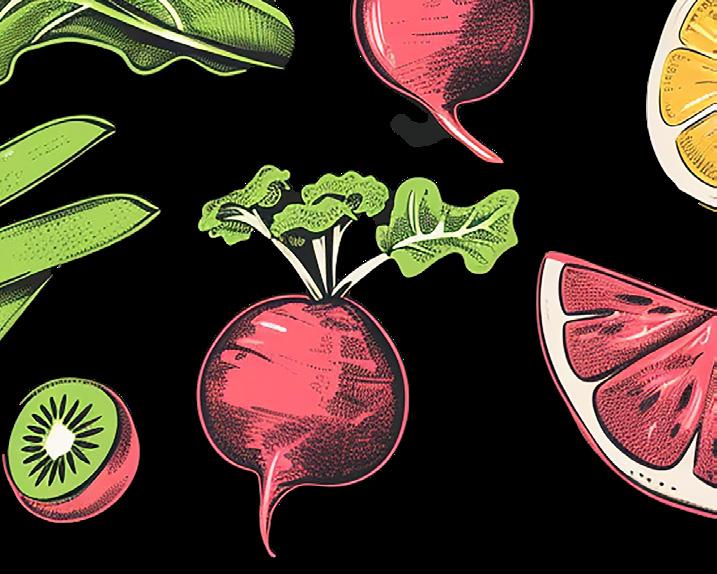
YOUR GUIDE TO SEASONAL
Rich in antioxidants, calcium, vitamin C, folate, iron, and potassium. They make a great, flavorful

Radishes Spring
PRODUCE

Anti-inflammatory and rich in beta carotene, lycopene, and potassium, which helps regulate blood pressure. Roast and serve alongside beets for a beautiful and
Pesach, with back-to-basics food choices, is the perfect time to showcase fresh Spring produce. In-season and full of health benefits, we can make it a week of clean eating. Be sure to check the ~ Vegetable Checking Guide at www.ok.org/vegetable-guide so your produce will be bug-free.
Grapefruit & Lemons
Great sources of vitamin C and fiber. Both make great juices, salad dressing ingredients, and add-ins for fish and poultry. Grapefruit also makes a great snack or palate cleanser.



Lettuce & Spinach
Rich in water, low calorie, and have many vitamins and minerals. There are around 40 varieties of lettuce, so you’ll be sure to find at least one to appeal to everyone. Romaine, traditionally used at the Sedarim, has a coarser feel and strong taste. Butter lettuce is the mildest variety, while endive (chicory) has a slightly bitter taste.
High in vitamin C, cop-


4 www.OK.org
Mangoes
Kitniyos

INGREDIENTS
6-8 strips bone-in flanken
Kosher salt, for sprinkling
Ground black pepper, for sprinkling Oil, for searing
2¼ cups Caramelized Onions (from 3 onion; page 264)
1 cup dry or semi-dry red wine
1 inch fresh ginger, minced, OR 2 frozen ginger cubes
2-4 Tablespoons sugar, optional
DIRECTIONS
1. Preheat oven to 275°F. Prepare a large baking dish.
2. Sprinkle salt and pepper very generously over the entire surface of the meat. Turn meat; repeat on the second side.
3. In a large frying pan, heat oil over high heat. Add flanken; sear for 1-2 minutes per side, until the outside is nicely browned. Place into prepared baking dish. Spread caramelized onions over the meat.
4. In a small bowl, combine wine, ginger, and sugar (if using); pour over the flanken.
5. Cover tightly; bake for about 5 hours, until fork-tender.
OnionSmothered Flanken
MEAT | YIELDS 6-8 SERVINGS
When I think of Pesach food, it’s hard not to think about caramelized onions. When I was growing up, we didn’t use any spices on Pesach other than salt and pepper, so I learned from my mother to coax the maximum amount of flavor out of all the fruits and vegetables we cooked with. This melt-in-your-mouth flanken really doesn’t need much to be perfect. Just a heaping ton of onions and a whole lot of time in the oven makes for the most extraordinary meat you’ll enjoy all Pesach long.
Plan Ahead
This flanken freezes nicely, well wrapped. Rewarm, covered, until heated through.
Variation
Instead of flanken, you can use other cuts of meat that work well with a low and slow cooking method, such as second cut brisket, minute steak or minute roast.
NEW FROM ARTSCROLL!

Real Life Pesach Cooking
Pesach prep - and Pesach food - for the way you live
Miriam (Pascal) Cohen understands your life. She knows how much work goes into Pesach preparations and, especially, Pesach cooking. She knows that the best Pesach recipes are about balancing beloved traditions with surprising innovation, for delicious meals that fit your lifestyle.
REAL LIFE PESACH COOKING INCLUDES:
• 150 no-stress recipes for delicious, creative Pesach foods
• Accessible ingredients and easy to follow instructions for smooth Pesach preparation
• All recipes are non-gebrokts and gluten free or have a gluten-free option
• “Homemade Staples” and “Minhag Modification” sections, perfect for those with various food customs
• Each recipe has “Plan Ahead” instructions for freezer-friendly and make-ahead cooking
• Chol HaMoed Travel Guide - recipe ideas and menus for day trips and overnight stays
• Beautiful, mouthwatering photo for every dish
www.KosherSpirit.com 5

When attending a wine tasting event, at a winery or private space, keep in mind that the hechsher on the wine only extends to the sealed bottle. It is important to make sure a Shomer Shabbos person pours the wine if it is not mevushal.
6 www.OK.org רוזעי המ ,תוללובתהו תוברקתה תישונא העפות תעינמל ןייה לושיב וידחי םיתוש םדא ינב ינששכ םאה ;וז תעדה בוריק םהיניב ןיא לשובמ ןיי !?בלהו הארנה יפכ יכ ,ש"ארה בישמ ךכ לע היהש ןייב קר ירכונ עגמ לע ורזג ל"זח תעב יוצמה ןייהש ןוויכמו .םנמזב יוצמ ןיי ןכ לע ,לשובמ ונניאש ןיי היה איהה אצמנו ,םימכחה תרזג ללכנ אל לשובמ עגנ ירכונ םא םג הייתשב רתומ אוהש .וב וב שיש ןיי לע קר ךוסינ תורוסא תולכאמ תוכלה( ם"במרה רתיהה תא קמנמ )ט הכלה ,אי קרפ רמוא אוה .רחא םעטב ,לשובמ ןיי לש קר םישמתשמ הרז הדובעלש ןוויכמש ,חבזמה יבג לע הברקהל יוארה ןייב לש ןיי רוסאל ורזג םימכחשכ ןכל יוארה ןיי לע קרו ךא ורזג םה ,םירכונ לשובמ ןיי ,ךכיפל .חבזמה לע ךוסינל יכ הייתשב רסאנ וניא ,ירכונ וב עגנש .חבזמה יבג לע ךוסינל יואר ונניא אוה ובריעש ןיי םג ,ם"במרה לש וז העדל רכוס וא שבד תמגודכ קיתממ טעמ וב ,ירכונ עגמ רחאל הייתשב רתומ היהי ךוסינל יואר וניא הזכ ןיי םגש ןוויכ שמשמ וניא םג אליממו( חבזמה לע .)הרז הדובעל תא ולביק אל ן"במרהו ש"ארה לבא דעוימה ןיי ןיב תרשוקה ם"במרה תעד הברקהל יוארה ןיי ןיבל הרז הדובעל ונאצמ ,םתנעטל ןכש .חבזמה לע לקד תוריפ םג הרז הדובעל םיבירקמש .חבזמה יבג לע םיברק םניא עודיכש לשובמ ןיי קרש ,ש"ארה קסופ ןכל ,ל"נה םעטהמו( ירכונ עגמב רסאנ וניא םימכחה ןמזב יוצמ היה אל הז ןייש .)וילע הלח אל הליחתכלמ הרזגהו 'ןיי' םֵשֵׁ ראשנש לכ ,ן"במרה תעדלו אוה ,הרז הדובעל שמשל לולעו וילע חבזמל יואר וניא םא ףא ,הרזגה ללכב וא ,'לשובמ ןיי' ,ךכיפל .שדקמה תיבב הלודג תומכ םע ןיי אוהש 'ןוטידנוק' 'ןיי'מ ומש הנתשהש דע שבד לש דאמ ,ונתשה וחירו ומעט םגו 'ןוטידנוק'ל ןיי תאז תמועל .הרזגה ללכב םניא 'ןיי' םש ןיידע ,שבד טעמ ול ופיסוהש הדובעל ותוא םג ךסנל םילולעו וילע די עגמב רסאי טלחהב אוה ןכ לעו ,הרז .ידוהי וניאש םדא דציכ ,תוללובתהמ ששחה יבגל המו ם"במרה יפלו( לשובמ ןייב ענמנ אוה וב ובברעש ןייב םג ,ותומכ םירבוסהו ?)המודכו שבד ד"וי ז"ט( םיקסופב רבסומ ךכ לע ועבק ל"זחש ,)דועו ,ג ק"ס גכק ןמיס תוללובתה ששח ינפמ הרזגה תא ךסונמ תויהל לולעש ןיי לע קרו ךא םירבד( קוספה ןושלכו ,הרז הדובעל יגוס לכ ןכל ."םָכיִסנ ןיֵי וּתְּשֵׁ י" )חל,בל הדובעל ךוסינ לש ששח םהב ןיאש ןייה אל םג ךכשמו ,הרזגב וללכנ אל ,הרז .ירכונ עגמב ורסאנ עגנש לשובמ ןיי תותשל רתיהל ,םוכיסל :םימעט השולש שי ירכונ וב לשובמ ןיי היפל ש"ארה תרבס .א ורסואל ורזג אל ןכלו ךכ לכ יוצמ וניא .ירכונ עגמ ידי לע וניא לשובמ ןייש ,ם"במרה תרבס .ב םג ןכלו חבזמה יבג לע ךוסינל יואר .ותוא םיכסנמ ויה אל הרז הדובעל ןוויכמ ,ותעיסו ן"במרה תרבס .ג ,רמולכ( 'לשובמ ןיי'ל ומש הנתשהש אוה ,ןיי ול איבהל שקבמ םדאשכ .לשובמל אלו ליגר ןייל ןווכתמ אוה לשובמ ןייב ןיינועמ םדאשכו יואר וניא םגו ,)שרופמב תאז ןייצמ רשק אלל( הרז הדובעל ךוסינל תיבב חבזמל יואר אל וא יואר ותויהל .)שדקמה תרוטרפמט יהמ 'לושיב'ה דוע לחהש — ןויד חתפנ ןאכ תורודל דע ךשמנו םינואגה תפוקתב יהמו לושיבה תמר יהמ — םינורחאה תא בישחהל ידכ תשרדנה הרוטרפמטה תורבוס תועדה תצקמ .'לשובמ' ןייה יפל .ןייה תא חיתרהל שממ ךירצש ןייה ןמ ולעיש ךירצ ,תורחא תועד .רסחת )תירוקמה( ןייה תומכשו םידא אהב אהש םירבוסה הכלהה יקסופמ שי ןייה ןמ םילועש עגרב רמולכ ,אילת תופסונ תועד .תרסחנ ותומכ – םידא בשחיי ןייש ידכש תורבוס הכלהב הנשתש הדימב לשבתהל וילע ,'לשובמ' יתלב ךפוה ןייה זא קר ןכש .ומעט תא .)הרז הדובעל( ךוסינל יואר רשפא ןהיפל ,תועד דוע שי[ תא תולעהלו לק לושיבב קפתסהל תדלוס דיהש םוחל ןייה תרוטרפמט תועד דוע ןנשיו .סויזלצ 45 -כ — וב רשפא יאו ןה תובר ךא ,אשונב ].ןטרופל ךורע ןחלושב )ד,גכק ןמיס( הכלהל קספנ ארקנ ןייש חתרשמ לשובמ ,שאה יבג לע םוקמב ך"שהו םשב( ראבמ )ן"רהו א"בשרה טעמתיש ונייהד ידי לע ותדיממ .החיתרה תדוקנ החיתרה ,השעמל ןייה תחיתר תדדמנ
הרוטרפמטב אלא
היולת
תוביס
עבקש יפכ האירבה עבטב ,ילוגסה לקשמה — ומלועב ךרבתי ירפסומטאה ץחלה ,לוהוכלאה תמר .'וכו יתביבסה ,םיה ינפ לעמ םיהובג םהש תומוקמב החיתרה תדוקנ ,ןלוגה תמר תמגוד .תיסחי הכומנ הרוטרפמטב רבכ היהת הבוגמ םיכומנ םהש תומוקמב וליאו ץחלה וב חלמה םי תמגוד ,םיה ינפ החיתרה תדוקנ – הובג ירפסומטאה .רתוי ההובג הרוטרפמטב היהת םימייקה םייעבט םיביכרל םג עקרק ,רכוסה תיראש — םיבנעב רמשמ ,ןָצפע( ןינאטה ביכרמו םלודיג שי – )םיבנעה תופילקב אצמנה יעבט .החיתרה תדוקנ לע )תמייוסמ( העפשה
הניא
,העובק
איה
המכב ארובה


ליל לש תויזכרמה תווצמה תחא ,ןיי תוסוכ עברא תייתש איה רדסה םישנה לעו םירבגה לע הלחה הווצמ עברא דגנכ ,תוסוכ עברא .דחאכ הרותב ורמאנש 'הלואג לש תונושל' ,"יתלצהו" ,"יתאצוהו" :)ז-ו,ו תומש( ."יתחקלו" ,"יתלאגו" תדחוימ בל תמיש תורושקה תווצמב םיקסוע ונא רשאכ אשונ תא שיגדהל דואמ בושח ,ןייב ירבד ראש דועב ,ןכש .ןייה תורשכ השענ םרוצייש ךכב יד הקשמו לכאמ חוקיפ תחתו םירשכ םלג ירמוחמ רצוויהל הלולע ןייב ,רדוהמ יתורשכ ךילהתש רחאל ףא הרומח תורשכ תייעב ,הכלהה יפל .םייתסה רבכ ולש רוצייה רמוש ידוהי ידי לע רצויש ןיי םג יתורשכ חוקיפ תחתו תווצמו הרות ימ םע עגמב אובי הזה ןייה םא ,רדוהמ ללחמה ידוהי םע ףא וא ,ידוהי ונניאש רשכ אל ןייה ךופהי – היסהרפב תבש .הרוסא ותייתשו בל תמיש שרוד הז אשונ ונא וב ,רדסה לילב תדחוימ םיחרוא ןימזהל םילדתשמ :'הדגה'ה תליחתב רמאנכו ."לוכייו יתיי ןיפכד לכ" אובל ןמזומ בערש ימ לכ םיחרואהו .ונתיא דועסלו ןחלוש לא ונמע םיבסמה דימת םניא רדסה ךכ .תווצמ ירמוש םירצלמה יבגל םג םידבוע וא ,םיירוביצ תומוקמב .וניניבש םירגובמה תא םידעוסה ,ןיי ןחלושל שיגהל םילולע הלא לכ — ב"ויכו ,םידעוסה ןיב ותוא ריבעהל .רשכ יתלבל ןייה תא ךופהלו 'הלגִנ'ב רוסיאה ימעט 'רתסנ'בו :ירכונ וב עגנש ןיי רוסאל ןידה רוקמ הרז הדובע תכסמ( הנשמב אבומ חנ ףדב ארמגה רואיב יפ לע ,ב,טכ דבוע( ם"וכע וב עגנש ןיי יבגל )דועו ,האנהב רסאנ אוהש )תולזמו םיבכוכ הרז הדובע ידבוע ללכ ךרדבש ינפמ – ןייב םהלש העיגנ לכ לצנל םילדתשמ רוסאל םימכח ורזג ףסונב .הרז הדובעל אוה םא םג ,ירכונ וב עגנש ןיי תייתש :ךכל םעטהו .הרז הדובע דבוע וניא םישנא רשאכ ."םהיתונב םושמ הרזג" בוריק םהיניב רצונ ,אתווצב ןיי םיתוש םורגל ןכמ רחאל לולע רבדהו תובבל םעטהמ .תוללובתהו תבורעת יאושינ לכ לש )'האנה' אלו( הייתש ורסא הזה .וב עגנ ירכונש ןיי םג ל"זח ופיסוה הלא םירוסיא לע עגנש )'האנה' אלו הייתש( ןיי תייתש ןוויכמ .היסהרפב תבש ללחמה ידוהי וב יניינעב ונילע ןמאנ וניא הזכ םדאש רמומ' לש ןיד וילע וליחה ,תורשכ ראובמ ,רבדה םעטב .'הרז הדובעל )םינואגהמ( 'תולודג תוכלה'( םיקסופב תבש לוליחש )הטיחש יניד ,ס ןמיס לעו םלועה תאירב דוסיב הריפכ אוה אנמחר( הרז הדובעכ איה ותועמשמ ןכ שיו .)ןלציל אוה הז רוסיא יכ םיריבסמה םיקסופ .תבש יללחמ לע וליטהש 'סנק' תריזג ,ל"זיראה תלבק יפ לע 'תימינפ'ו תינחור איה תוללובתהה האמוטה תוחוכל התנווכו ,ומצע םדאב ןיי התושש ימ םע רבחתהל םילולעה ללחמה םדא די עגמ ,ןכ ומכ .רשכ אל .ןייה תא רסוא אוה םג היסהרפב תבש )בל,בל םירבד( קוספב זמורמ הז ןיד תֹר ר מ תלֹ כְּ ְשֵׁ א שֵׁ וֹר יֵבְנְִּע וֹמֵב נ ע " יבר תעדל ןכו ,יסוי יבר תעדל ."וֹמָל הבר תישארב( יאעלא יבר ןב הדוהי יבנע"הו ,היה ןפג ץע תעדה ץע ,)ז,וט םה האירבה
)ןושארה םדא אטח
םירבדה .םיאבה תורודל "תורורמ" ןכש ,"ו'מ'ב'נ'ע" הלימב םיזומר ףא וז הלימ תויתואל תומדוקה תויתואה ,ערה ךאלמה לש ומש – 'ל'א'מ'ס ןה תעגל הוח תא התיפש שחנה תניחבב תויתואש ,הז דוסבו .ןפגהמ לוכאלו הלימל תודומצ ער ךאלמ ותוא לש ומש ןיי תייתש רוסיא תא ורזג ,"ומבנע" .ירכונ וב עגנש הרזגב ללכנ אל ידי לע רסאנ וניא ,לושיב רבעש ןיי :ירכונ תעיגנ לשבתהש רחאל ןייש ךכל רוקמה ,ירכונ עגמ ידי לע הייתשב רסאנ וניא .)א,ל הרז הדובע תכסמ( דומלתב אוה ןייהש רחאלש ,תראבמ םש ארמגה רתומו 'ךסנ ןיי' םושמ וב ןיא לשבתה ואיבה םש 'תופסות'ה .ותוא תותשל םיאורש יפכו ,הכלהל קספנ ךכש התש לאומשש ,ארמגב השעמל הכלה .וב עגנ )יוג( "טָלבא"ש ףא לע ןייה תא ןוויכמ :הלאשה תשקבתמ ןאכ תעינמ ,רומאכ ,איה רוסיאה תביסש
ןמז תוסוכ עברא תונורתפו םירגתא דלפניו יולה םייח המלש ברה תאמ ~ Executive Kashrus Vaad www.KosherSpirit.com 7
תליחתב ויהש "שאר
לש ויטעב( ומרגש
ונתוריח

8 www.OK.org דעו םעטמ חקפמ ךרעש הקידבב לאומש ברה ג"הרה ,ייק וא תורשכה ילכב החיתרב ,א"טילש ןמלדיא תומוקמב ,לארשי ץרא ןופצב ,חותפ םוחב החיתרל עיגה ןייה – םיהובגה תומוקמב דועב ,סויזלצ תולעמ 84 לש תולעמ 86 -ל קקזנ ןייה םיכומנה .החיתרל עיגהל ידכ סויזלצ רוטספ ידי לע 'לושיב' ןתינ םאה ,הלאשב ונד רודה יקסופ .'לשובמ'כ רטסופמה ןייה תא בישחהל ןוגכ תולאש תודמוע ןיינעה שרושב לע םאה ןכו ,רוטספה תרוטרפמט יהמ הנתשמו ותדיממ רסחנ ןייה רוטספ ידי .ומעט וניה ןייה רוטספ ללכ ךרדב השענ אוהו ,םיקדייחה תתמה ךרוצל לש הרוטרפמטב ,הרוגס תרטספמב תיצחמכ ךשמל ,סויזלצ תולעמ 68 -כ לכו ררקתמ ןייה הירחאלש ,העשה אופא אצוי .ןייה ילכמל רזוח לזונה תדוקנל עיגמ וניא ןייה ליגר רוטספבש ותדיממ רסחנ וניא אוה םגו החיתר הב ןיאו הרוגס רוטספה תכרעמ ןכש( .)םידא לש רורחש תוטשפ( תועדה בור ,תאז רואל תורבוס )ך"שו ךורע ןחלושה ןושל קרו .'לושיב' בשחנ וניא ליגר רוטספש 'לשובמ' בשחנ ןייש תורבוסה תועדל הב תדלוס דיהש הרוטרפמטב רבכ ןיא םג ןכ ומכו )סויזלצ תולעמ 45-כ( אלא ,לעופב ותדיממ רסחי ןייהש ךרוצ התואב( 'לושיב'ה היה וליאש ךכב יד החותפ תכרעמב עצבתמ )הרוטרפמט תועדל – םידא תאיציל םרוג היה אוה ליגר רוטספ בישחהל היהי ןתינ וללה .'לושיב'כ תונורתפ תרוש םיישעמ וא תורשכה ןוגרא חוקיפבש תונייב ןד ברה ןוגראה אישנ תארוה יפל ,ייק לשבל לכונש תנמ לע ,ה"ע יוויל לאוי שרדנ בקיה ,רוטספה תכרעמב ןייה תא ךותב החיתרה תדוקנב םותסש ןיקתהל ואצי החיתרה ןמזבש ךכ ,תרטספמה היהי ןייהו םותסש ותוא ךרד םידא עיגהל תנמ לע ,ןכ ומכ ;ותדיממ רסחנ ןייהש םידיפקמ ונא החיתרה תדוקנל תולעמ 87-86 לש הרוטרפמטל עיגי תדוקנל עיגמ םג ןייה ךכ .סויזלצ ןתואל ףאו .ותדיממ רסחנ םגו החיתר הנתשי ןייה םעטש תוכירצמה תועד ןייש שחומב םיאור ,לושיבה ידי לע הנתשמ ןכא ומעט – החיתרב לשבתהש ךורא ןמז ךשמל ןושייל יואר וניא אוהו יואר וניא הז ןייש תועד שיש דע[ .]!'לוכהש' ותכרבו שודיקל ןיי יכ םירבוסה שיש ףא לע ,םוכיסל וא הלדבהו שודיקל יואר וניא לשובמ שיו הדימב ,תאז לכ םע ,תוסוכ עבראל – תווצמו הרות ירמוש םניאש םיחרוא לשובמ ןיי ןחלושה לע דימעהל ףידע ךרבלו שדקל ןתינו ,םיבנע ץימ וא .םיבנע ץימו לשובמ ןיי לע 'ןפגה' אוה ששחה םא ,'יולה טבש'ה תעדל ןתינ ,תבש ירמוש םניאש םיחרואמ קר רוטספ רבעש ןייב שמתשהלו לקהל .ליגר רשפא ,לשובמ וניא ןייהו הדימב תא 'םידבכמ'ש ךכב תומיענ יא עונמל .םהיתוסוכל ןייה תא םיגזומו םיחרואה עיגהל רוסא בצמ לכבש רוכזל שי ודובכ לע רומשל ךירצו ,סעכ ללכל .םדא לכ לש תעד לע ךומסל איה תפסונ תורשפא ןייב שמתשהלו ,ונרכזהש ם"במרה וא שבד תמגודכ קיתממ ול ופיסוהש .קותמל ןייה םעט יוניש םרוגה רכוס ןחלשב םג תאבומ ם"במרה תעד םשו )ד,גכק ךסנ ןיי תוכלה( ךורע .רסאנ וניא קתוממ ןייש הכלהל קספנ ול ופיסוהש ןייש ,ז"טה םש קספ ןכו םג רתומ – ומעט הנתשהו קיתממ ול ופיסוהש ןייש וקספש שיו[ הייתשב עגמ ידי לע האנהב רסאנ וניא קיתממ הייתשב רוסא היהי ןיידע לבא ,ירכונ .]ש"ארה תעדכו םה םא :םמצע םיחרואה יבגל ,תווצמו הרות ירמוש םניאש םידוהי םהש ןייה תא תותשל םהל רתומ ,לשובמ וניא םא ףא ,וב ועגנ םמצעב םה הבש הווצמ תדועסב םהשכ טרפבו 'הבושת תיישע' לש תמייוסמ העונתב היסהרפב עגרכ םידרומ םניא םהו םהילע ליחהל ןתינ הז הרקמב .הרותב תא ולביק אלו 'ובשִנש תוקונית' רדג .הביבסהמ ועפשוה וא יוארה ךוניחה ירכונ 'תייאר'מ תוריהז בתכש המ ריכזהל יואר ,םויסל 'תויתואה רעש'ב( שודקה ה"לשה ימעט' רפס םשב ,הליכאה תשודקב ,)ילבבה םחנמ 'ר ברה רביחש 'תווצמ םמצע לע ורימחהש השעמ ישנא הארש ללכו ןייה תא האר קר יוגה םא וליפאש .ןייה תא םיתוש ויה אל – וב עגנ אל ןיא בוש ,ןייב ויניע ןתנש עגרמ ןכש ,אוה 'ןיקיתו גהנמ'ו .הכרב ןמיס וב חירמ וא ןייה ןווג האור לרעהש ןוויכמ ,ותבשחמב ול אוה הוואתמ ,וחיר תא .הרז הדובעל ירכונ תבשחמ םתסו רמושמה ןיי"ל הכוז ותייתשמ רהזנהו םיקולא חמשמ"ה הזכ ,רֵחא "ויבנעב .תוכרבב "םישנאו רומשל שי ל"זיראה תלבק יפ לע םג ןייב דחוימב ,ירכונ תייאר מ ןייה לע וא הלדבה ,שודיקכ תווצמל דעוימה .חספ לש תוסוכ עברא ירכונמ קר איה 'הייאר' לע הדפקהה הרות רמוש וניאש ידוהי תייארמ אלו תרסוא הניא ןבומכ ותייארש ,תווצמו .ןייה תא םויסב ,החנמה תולעב ,חספ לש ןורחאב המכב םיגהונ וב 'חישמ תדועס' ןמזב 'תוסוכ עברא' תותשל לארשי תוליהקמ תא קזחלו רוכזל תנמ לע ,ןיי לש הלע ,אובל הבורקה הלואגב הנומאה ח"הגה ןוגראה אישנ המימשה הרעסב ןותנו רוסמ היהש ה"ע יוויל לאוי ןד 'ר תוריסמב ,תורשכה תומוח תרימשל .שממ שפנ הכרדההו הבשחמה תוריהב לע דמועה אשונ לכב ולש תיתכלהה .תורשכה םלועל דואמ תורסח ,קרפה םויקל הכזנ בורקב יכ הליפת ונא וּננְַּרו וּציִקה" )טי,וכ והיעשי( דועייה ~ .םכותב ה"ע יוויל ברהו "רָפע יֵנכֹשֵׁ
YOSHON Q&A

I’m a growth-oriented person and I would like to take on additional Halachic stringencies. I'm already makpid on Cholov and Pas Yisroel and now I’d like to take on yoshon. The only trouble is that I am not sure what it entails.
• Should I take it on?
• How difficult is it?
• Is it year-round or only during certain seasons?
• Does yoshon (old) mean that I can’t have fresh bread anymore?
• Can I be stringent even if the rest of my family is not?
• Do I need separate pots and pans?

Q: A:
By Rabbi Yakov Teichman, ~ Rabbinic Coordinator
In this article, you will learn that spring is an opportune time to learn about the Halachos of yoshon (also referred to as chodosh [new]). Although an all-encompassing analysis is beyond the scope of this article, we can cover the basics.
The Torah says that one may only consume the “Five Grains” (wheat, barley, spelt, rye, and oats) if they are “old” (yoshon). According to the Torah, if a grain takes root before1 Pesach, then, on the second day of Pesach, it becomes yoshon. In the time of the Beis HaMikdash, the grain became yoshon immediately after the Kohen brought the korban omer. Once the Beis HaMikdash was destroyed, grains became yoshon after the second day of Pesach ended.
1
www.KosherSpirit.com 9
Some say 3 days, and some say 2 weeks; םש ףסכה תודוקנו 'ב ק"ס ג"צר 'יס ד"וי ך"ש

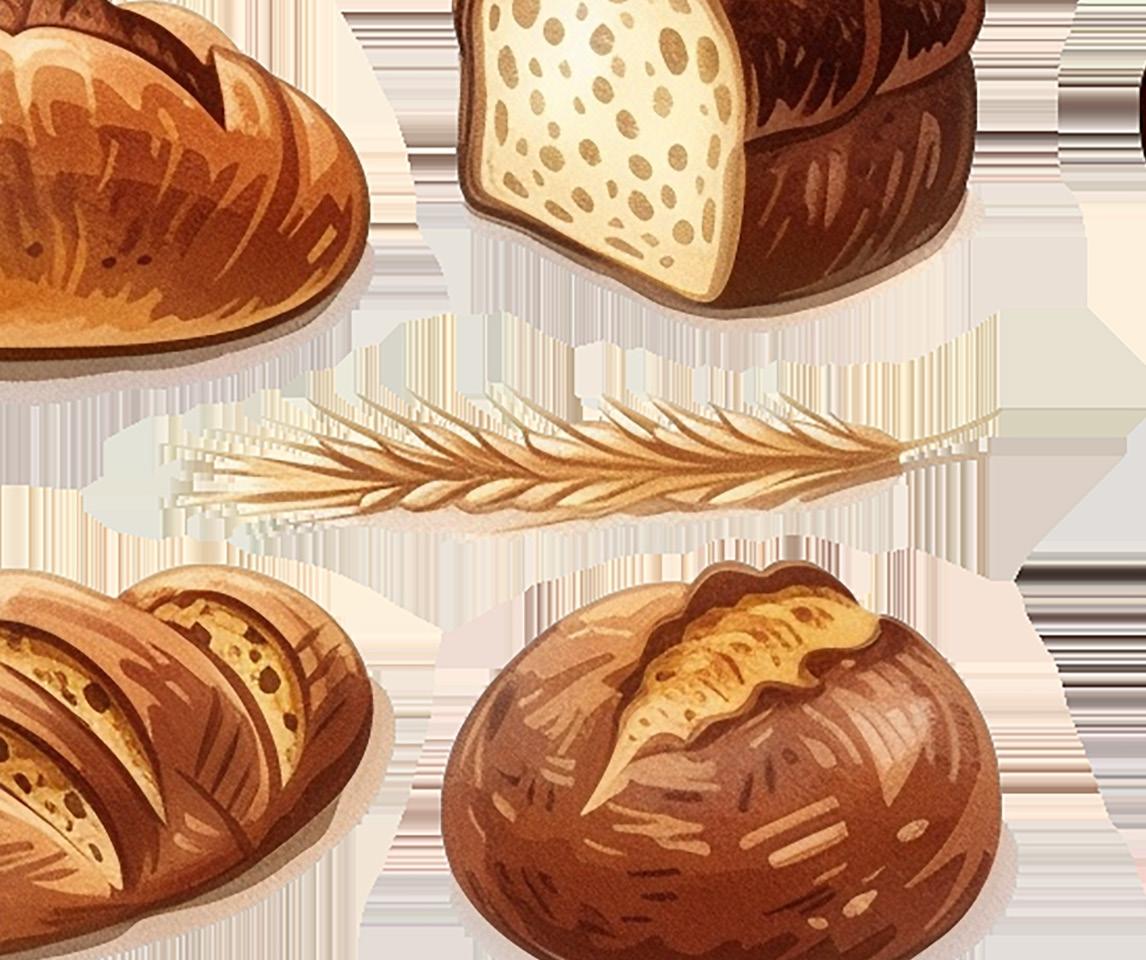
ends of the spectrum for each variable. For Sephardim, the Shulchan Oruch is machmir2 and does not leave any room for leniency. For Ashkenazim, the Rema3 opines that most people are lenient. The Shulchan Oruch HaRav 4 writes that the prevailing custom is not to be strict with the prohibition of chodosh; however, a “Baal Nefesh” (one who cares for their soul) should not rely on the lenient opinions and should be careful not to eat chodosh. (Editors note: Despite this ruling of the Shulchan Oruch Harav, the custom of most Chassidic communities is still to be lenient with chodosh.5 ) The Vilna Gaon6 and Mishna Berurah7 are of the opinion that one should be strict - the Mishna Berurah writes that even though those who are lenient have what to rely on, one who is a yarei shamayim should be strict with the halachos of Chodosh. The prevalent minhag in prewar Europe8 and until recently in North America was to be lenient.9 There is a mesorah in the name of the Baal Shem Tov to be lenient as well. It is only recently
2
3
4
6
5
that the stringency of yoshon has become more common.
Now that we have the Halachic overview, we can discuss yoshon practically.
Since any of the Five Grains that took root before Pesach are yoshon, all the grains available from Pesach until the new crop reaches the retail market are yoshon. The process of growing, harvesting, milling, and packaging takes a few months, and the new crop will not be on the market before July. Some of the “new crop” Five Grains may not be available until September. Spring is the perfect time to learn about the ingredients that comprise your favorite products and how to determine the yoshon status.
SPRING IS THE PERFECT TIME TO LEARN ABOUT THE INGREDIENTS THAT COMPRISE YOUR FAVORITE PRODUCTS AND HOW TO DETERMINE THE YOSHON STATUS.
There are two main grain crops during the year, the winter crop, and the spring crop. Farmers sow the winter crop during the winter and harvest it in the spring (after Pesach), so it is already yoshon by harvest time. Farmers sow the spring crop in the spring and harvest it in the early summer. The solar calendar date corresponding with Pesach will determine the yoshon date for the spring crop each year.
On an agricultural level, the weather affects the taste and composition of the grains so different recipes favor grains from different seasons. For example, cake flour vs. bread flour.
A person who is makpid on yoshon has a few pur chasing options. One can stock up before the spring grain season begins (sometime during the summer) with enough product to last until the next Pesach. Proper storage is essential to mitigate any insect con cerns. Another option is to buy only products that are certified as yoshon. This is the simplest option, but it

8 The fact that people in Europe had very little to eat, and there wasn’t easy access to food staples from other locales, was another reason people were lenient.
9 There is an interesting historical tidbit that the USA used to have a major surplus of wheat and all consumers were getting wheat from a few years prior, so essentially all the wheat on the market was Yoshon. However, in the early 1970s, President Nixon sold all the surplus wheat to Russia as part of a deal to aid in ending the Vietnam War. (https://thislandpress.com/2016/12/06/the-secret-wheat-deal/)

'ג ףיעס ג"צר 'יס ד"וי
םש
'ל ףיעס ט"פת 'יס ח"וא ברה ע"וש
פ"שחא ,מ"שת שדוק תוחיש
ד"נ ק"ס ט"פת 'יס ןויצה רעש ןייע
ה"מ ק"ס ט"פת 'יס
7
10 www.OK.org
is more limiting. Here is a golden nugget, all products produced in Israel are always certified as yoshon. And, lastly, one can learn about how product codes translate to production dates to determine yoshon status. There is a wealth of information published online for those who would like to learn.

Yoshon has a unique status when it comes to its effect on keilim. The consensus of the Poskim is that yoshon status only affects keilim if one is 100% sure that it was used for something that was not yoshon. If one is not 100% sure, one may use the same utensils. If one does know 100% that a utensil was used with something that was not yoshon, one should refrain from using the utensil for 24 hours.
As a Halachic policy, ~ Kosher does not require certified products to be yoshon; however, if a company labels their product as yoshon or if a res taurant advertises it as yoshon, we ensure that all the ingredients are yoshon. Yoshon at a restaurant or a fac tory producing retail products is identi cal to yoshon at one’s home, albeit on a grander scale. Yoshon at the mill that is grinding the flour can be ensured in one of two ways. There can be a mash giach temidi who segregates the yoshon grains/flour and then returns to super
So, to respond to your original questions:
Should you take it on?
This is something to discuss with your Rav.
How difficult is it to keep yoshon?
You need to put thought into your meals daily.
When do I have to worry about yoshon?
About 6-9 months a year.
Does it affect the taste of your food?
No.
Can I be stringent if my family is not?
Yes, and you do not require separate pots and pans.
I will leave you with one thought, in recent years, society has become accustomed to everything on demand (think grab ‘n go food, “Googling” the answer to a question, 2-day shipping, Instacart, etc.) and we often take the kosher status of food for granted. Sometimes we even pick up a product that was kosher for years and don’t realize that it is no longer kosher. If you are stringent with yoshon, then you will always read the product label. Oh, and your nutritionist may start relying on you for the nutrition facts. ~


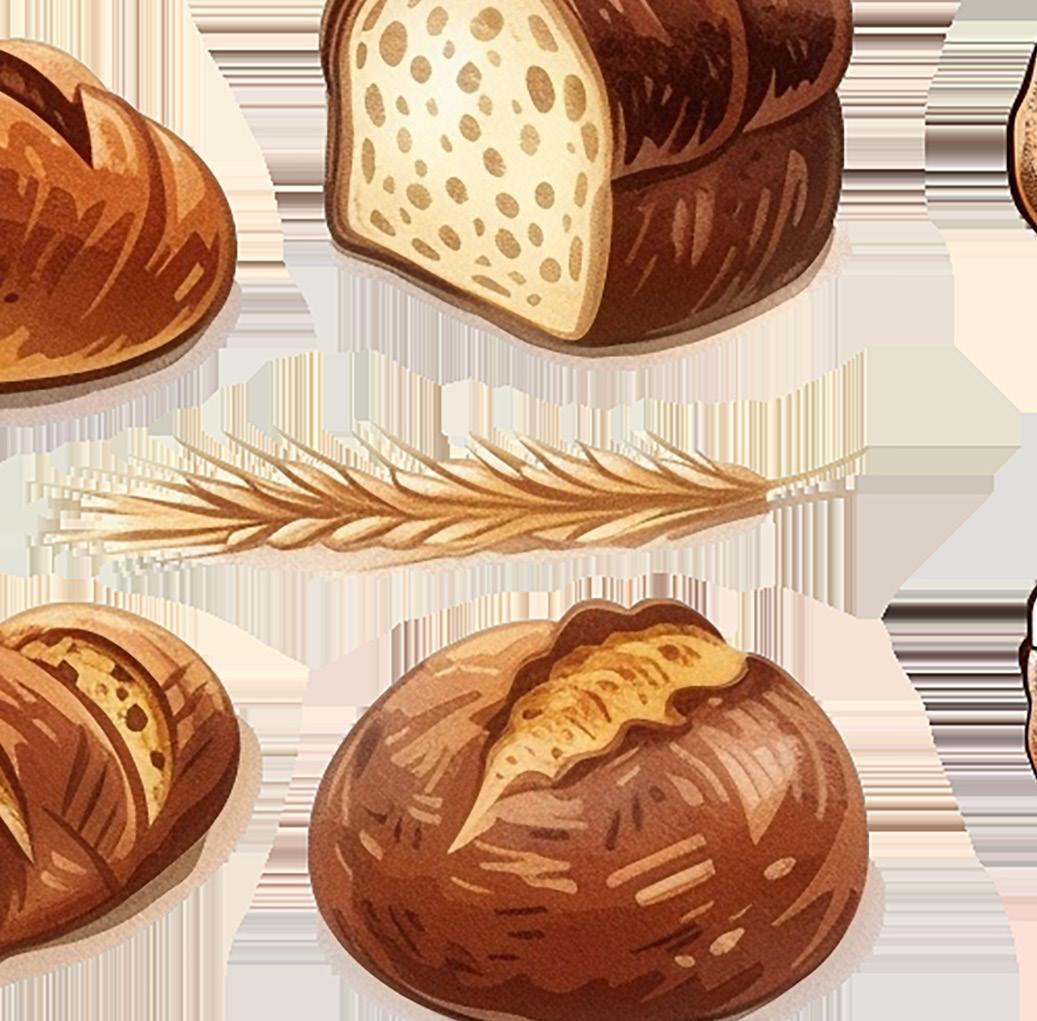


www.KosherSpirit.com 11

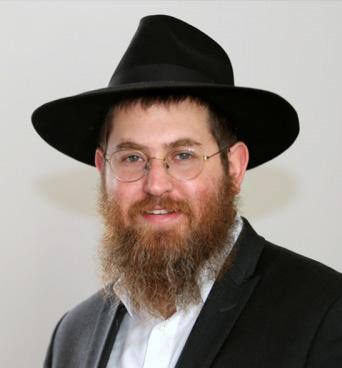
 By Rabbi Sholom Kesselman, ~ West Coast Food Service Coordinator
By Rabbi Sholom Kesselman, ~ West Coast Food Service Coordinator
IS CULTURED MEAT KOSHER?

12 www.OK.org
The first cultured beef burger patty was created by Mark Post at Maastricht University in 2013. It was made from over 20,000 thin strands of muscle tissue and cost over $300,000 to produce. The burger was tested on live television in London on August 5, 2013, and was cooked by chef Richard McGeown and tasted by critics Hanni Rützler and Josh Schonwald.
Rützler commented that the consistency was perfect and that it was close to meat, adding that she would have taken the product for meat rather than a soy copy even in a blind trial.
Growth of the Lab Grown Meat Industry
The lab-grown meat industry has seen tremendous growth in recent years, with multiple companies and research institutions working on developing this technology. Some key milestones in this process have been:
In 2020, Singapore became the first country to approve the sale of labgrown meat, with Eat Just's cultured chicken product hitting the market.
In 2023, U.S regulators approved the sale of cultured meat to consumers for the first time.
In 2023, Israeli startup SuperMeat obtained kosher certification for their lab-grown chicken products.
Also in 2023, the Chief Rabbi of Israel issued a controversial ruling that the lab grown meat of Aleph Farms can be considered pareve.
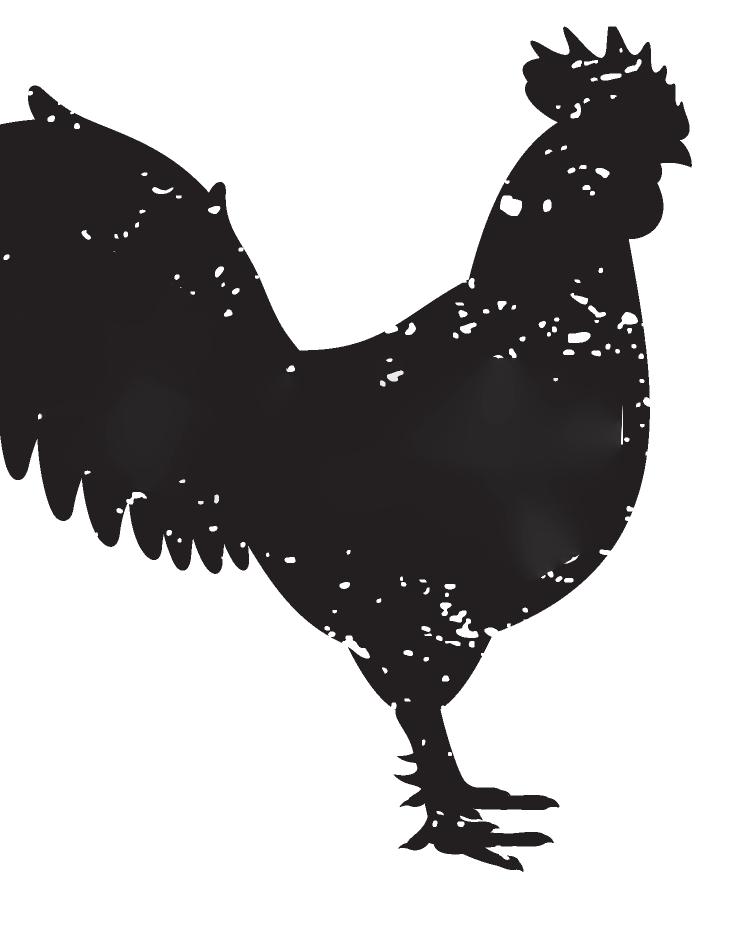
The industry is expected to continue growing, with many companies aiming to launch their products in the next
few years. The increasing demand for sustainable and ethical food sources, along with advancements in technology, will likely drive the growth of the labgrown meat industry.
Lab-Grown Meat: The Science and Process Behind the Revolutionary Food
Lab-grown meat, also known as cultured meat or clean meat, is made by growing animal cells in a controlled environment, rather than raising and slaughtering animals. This innovative technology has been gaining attention for its potential to address the ethical, environmental, and health concerns associated with traditional animal agriculture.
But how exactly is lab-grown meat made?
Cell Selection and Isolation
The first step in producing labgrown meat is to select the type of animal cells to use.
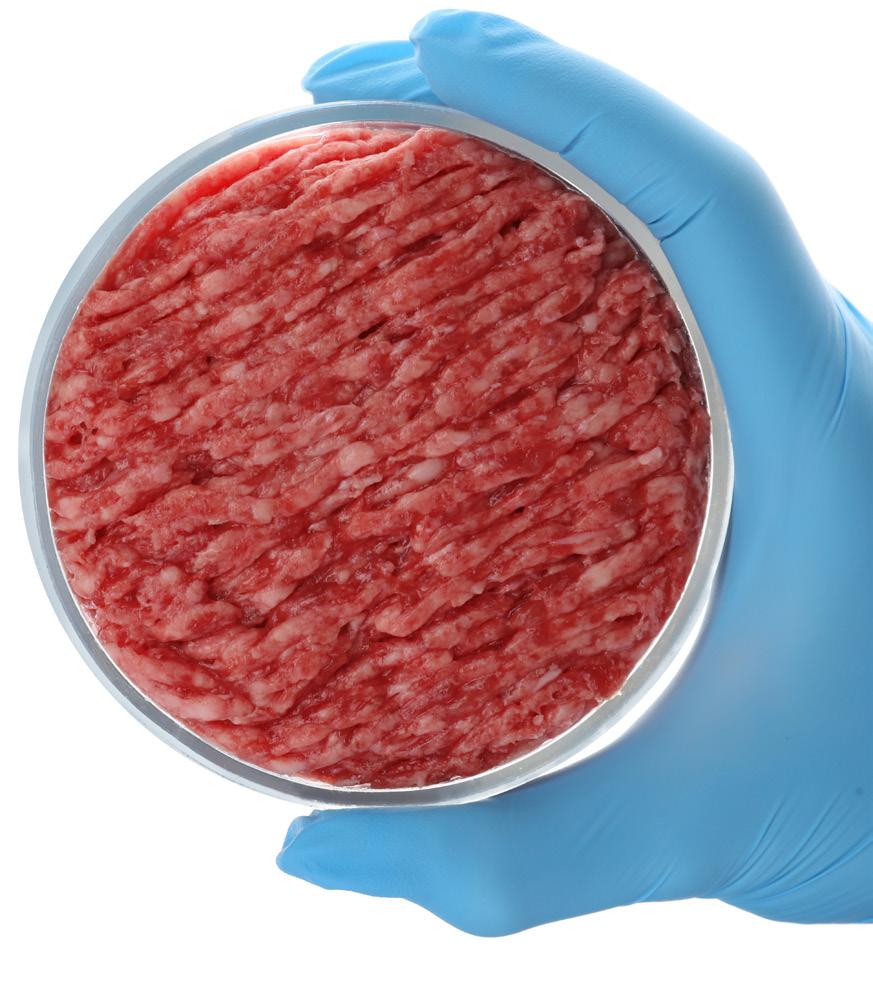
cells for meat production are myocytes (muscle cells) and fibroblasts (connective tissue cells).
In Aleph Farms' case, the stem cells were obtained from fertilized embryos rather than from muscle tissue cells. In the case of SuperMeat, the stem cells were likewise obtained from a fertilized egg.
Once the cells are isolated, they are cultured in a nutrient-rich medium that promotes cell growth and division. This medium is typically derived from a combination of natural and synthetic sources. Some common components of cell culture media include:

www.KosherSpirit.com 13
1. SERUM: A protein-rich component derived from animal blood, often from bovine or porcine sources. Serum provides essential nutrients, vitamins, and growth factors for cell growth.
2. ALBUMIN: A protein derived from animal sources, often bovine or human, which helps maintain cell growth and viability.
3. AMINO ACIDS: The building blocks of proteins, essential for cell growth and differentiation.
4. VITAMINS: Essential nutrients like vitamin B12, vitamin E, and others, which support cell health and metabolism.
5. MINERALS: Essential inorganic nutrients like calcium, potassium, and others, which regulate cellular processes.
6. SUGARS: Carbohydrates like glucose or fructose, which provide energy for cell growth.
7. SALTS: Inorganic compounds like sodium chloride, which maintain osmotic balance and support cell growth.
8. GROWTH FACTORS: Proteins that stimulate cell growth and differentiation, such as FGF and VEGF.
9. ANTIBIOTICS: Added to prevent bacterial contamination and promote cell growth.
The cells are then grown in a controlled environment, such as a bioreactor, where temperature, pH, and oxygen levels can be closely monitored and ad
needed. This ensures that the cells are provided with an optimal environment for growth and differentiation. The bioreactor also allows for continuous monitoring and control of the cell growth process, enabling the production of large quantities of highquality cells for meat production.
Cell Proliferation and Differentiation
As the cells grow and divide, they are induced to differentiate into muscle fibers through a process called myogenesis. This process involves mimicking the natural signals that cells receive in the animal body to promote muscle growth.
Tissue Formation and Maturation
mimics the natural extracellular matrix, the cells can interact with the scaffold and each other in a way that promotes tissue formation, leading to the growth of robust and organized muscle tissue. This tissue formation process allows for the creation of labgrown meat that closely resembles the structure and texture of traditional meat.
As the tissue grows and develops, it requires an increasing amount of nutrients and oxygen to support its expansion and metabolic activity. To address this, tissue is often perfused with a nutrient-rich medium that provides the necessary nutrients, such as glucose, amino acids, and vitamins, and oxygen to support cellular metabolism. This medium also helps remove waste products, such as lactic acid and carbon dioxide, that can accumulate from cellular activity.
Maturation of the tissue is critical to achieve the desired texture and flavor. This process can take several weeks to months, during which time the tissue is monitored for quality and safety. ~


Once the cells have differentiated into muscle fibers, they begin to form into tissue-like structures through a process called tissue formation. This process is enhanced by providing a scaffold or matrix for the cells to attach to and grow on. The scaffold serves as a three-dimensional framework that supports the growth and organization of the muscle fibers, allowing them to develop into a cohesive tissue. The scaffold can be made of natural materials, such as collagen or fibrin, which are identical to the extracellular matrix components found in animal tissue, or synthetic materials, such as polylactic acid or polycaprolactone, that mimic the structure and function of natural extracellular matrix. By providing a scaffold that

14 www.OK.org
Halacha
The advent of lab-grown meat has prompted a thorough examination of its Halachic implications. In this multi-part series, we will explore several complex Halachic questions about the Kosher status of such meat. Here are the questions that will be addressed: 1 3 5 7 9 11 2 4 6 8 10
Non-Kosher stem cells
If the stem cells originate from a non-kosher animal, does this preclude the resulting meat from being considered kosher?
Kosher Slaughter
Must the animal have undergone kosher slaughter for the stem cells to be considered kosher?

Blood
Can stem cells be derived from animal blood, given that blood is not considered kosher for consumption?
Scaffolding
What are the kashrus requirements for the scaffolding material used to support the growth of the stem cells?
Cell Origin
Does the location within the animal from which the stem cells are extracted impact the meat/pareve status of the resulting cultured meat?
Ma’aras Ayin
Kosher stem cells
Can the stem cells be harvested from a living kosher animal, or is this a form of eiver min hachai?
Salting
Must the animal have undergone “melicha” (salting to remove the blood), before the stem cells are procured?
Culture Medium
What are the kashrus requirements for the culture medium used to nourish the stem cells? May serum/albumin, which is often derived from animal sources, be utilized?
Meat Status
Is cultured meat considered fleishig (meat) or pareve (neutral) for the purposes of Halacha?
Medium and Scaffolding Impact
Do the kashrus requirements of the culture medium and scaffolding material affect the meat/pareve status of the cultured meat?
How can we address the concern of ma’aras ayin, which dictates that foods must not be prepared in a way that could be misleading or appear to be something they are not, in the case of lab-grown meat that closely resembles traditional meat?
These questions and more will be explored in this multipart series featured in the next few editions of Kosher Spirit.
www.KosherSpirit.com 15
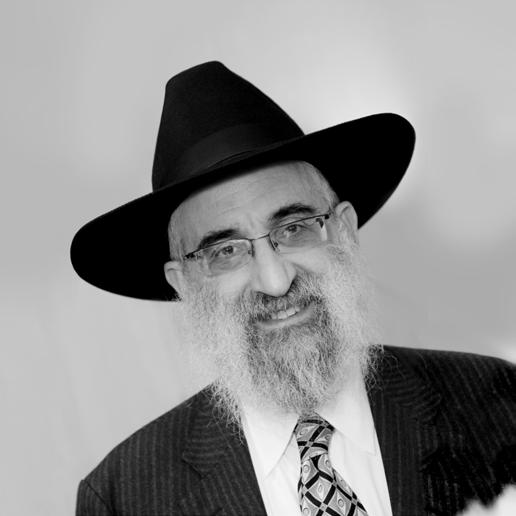

I came to ~ Kosher in the role of Rabbi Levy’s executive assistant in 2002, and for the next 18 years, I had the privilege to work alongside him.
Rabbi Levy had high expectations of me, and of all his employees, but no more than he demanded of himself. Yet he always recognized and appreciated our efforts. Throughout the years, I observed his unfailing dedication to maintaining the highest possible kashrus standards, and to raising those standards throughout the industry. As his father, Rabbi Berel Levy OB”M, had done before him, Rabbi Levy extended ~ Kosher’s certification to every region of the world, with the goal of providing high quality kosher products to Jewish communities everywhere.
Beyond his professional attain-

ments, Rabbi Levy was a tremendous baal chesed and baal tzedakah. He supported many institutions and projects that were dear to his heart. But more than that, he often reached out to help when he heard of someone in desperate need – without fanfare or public accolades.
Despite his busy schedule, Rabbi Levy made time to learn and give shiurim on a daily basis, serving as Rav of his shul – Bais Eliezer Yitzchok. He was a Chossid who strived to fulfill the directives of the Lubavitcher Rebbe. But most of all, Rabbi Levy was devoted to his wife and family.
A giant in his field, Rabbi Levy was essentially a humble man who knew his priorities and pursued them with utmost dedication.
16 www.OK.org
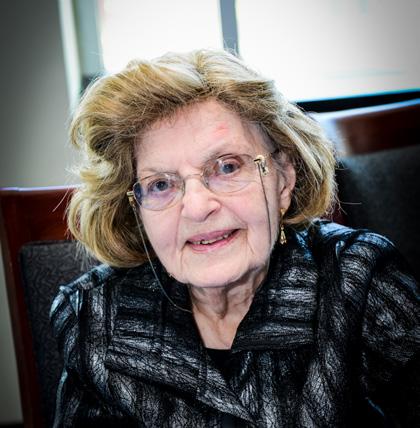
Mrs. Levy was an exceptional individual, leaving a lasting impression on those fortunate enough to know her. Her regal demeanor, strong work ethic, and a deep sense of family values are qualities that undoubtedly left a mark on everyone she encountered.
I would like to share a story. One year, I received a phone call from Mrs. Levy after Pesach. She was calling simply to express gratitude as she noticed I worked during Chol HaMoed. This is a testament to her appreciation for hard work and her ability to make every employee feel valued. Her commitment to recognizing and acknowledging the efforts
of others speaks volumes about her character and leadership style.
Furthermore, the joy she expressed upon the birth of her granddaughter's long-awaited first child highlights her deep love for her family and her ability to find happiness in life's most precious moments. Mrs. Levy's legacy lives on through her impact on her employees and her family. Her values and principles continue to inspire those who were fortunate enough to know her, serving as a guiding light for generations to come.


www.KosherSpirit.com 17

BRAZIL A JOURNEY FOR KASHRUS
By Kosher Spirit staff, including interviews with Rabbi Eli Lando and Rabbi Noriel Eliezer
Rabbi Eli Lando, the Executive Manager of ~ Kosher, embarked on a journey through Brazil back in December, accompanied by Rabbi Noriel Eliezer, ~ Kosher’s key mashgiach in Brazil. Upon his return, Rabbi Lando sat down with us to unravel the captivating narrative of kashrus in Brazil. With passion resonating in his voice, he emphasized the profound significance kashrus has in our everyday lives, urging kosher consumers to recognize its impact and the unwavering dedication needed to maintain its standards.
In the heart of Brazil's sprawling agricultural expanse, where soybeans, sugarcane, corn, and coffee fields create a vibrant tapestry, the industrial food sector has become a dynamic force in global markets. The logistical challenge of travel within this vast country becomes apparent, requiring returns to central cities to reach different points. This complexity adds layers to our exploration, making the days longer than any normal travel in other countries. This story unfolds not just as a narrative of Brazil's supply prowess but as a fascinating journey into the intricate world where food and beverage manufacturing

meet the global demand for kosher certification.
Amidst this culinary landscape, ~ Kosher emerges as a guardian of confidence, ensuring an unwavering commitment to kosher standards.
The influence of ~ Kosher in Brazil has grown significantly in the last 15 years, especially with the involvement
As their journey unfolds, the story of Brazil's industrial kashrus becomes more than just a tale of growth and challenges.
of Rabbi Noriel Eliezer.
Rabbi Noriel Eliezer, born to Jewish immigrant parents in Brazil, brings a unique blend of cultural understanding and religious devotion to the kosher certification process. His journey of rabbinical training,
spanning Brazil, Israel, and the USA, contributes to the rich tapestry of his experiences. This diversity is mirrored in his relationship with ~ Kosher and Rabbi Ouriel Allouche, the direct supervising Rabbinic Coordinator. Rabbi Allouche assumed responsibility for certifications in Brazil some years ago. He ensures the highest quality of kosher standards in Brazil in accordance with the instructions and guidelines of ~ Kosher’s Vaad HaKashrus, reviewing every inspection report, guiding Rabbi Noriel Eliezer, overseeing the entire certification process, and making regular visits to Brazil.
In addition, visits by additional from our offices are conducted in Brazil regularly as a continuation of the tradition of our mentor and late Rabbinic Administrator, Rabbi Don Yoel Levy OB”M. Rabbi Levy wanted a second pair of eyes, in addition to the mashgiach, and insisted on detailed written reports that allow even those


18 www.OK.org

who have not visited the specified company to get a complete picture of the production and kashrus requirements and can answer questions posed by other rabbis or consumers. Rabbi Levy's passion for information preservation, something that really sets ~ Kosher apart as an organization, could be an article unto itself!


Rabbi Allouche and Rabbi Noriel have succeeded in substantially growing kashrus in Brazil. Rabbi Noriel highlights the support he receives from Rabbi Lando and the ~ Kosher staff as a turning point in his work. “Rabbi Lando provided me with all the tools to set up a sustainable network, where we exchanged ideas several times a week by phone. This was essential to the growth of kashrus in Brazil. I was given a strong support system, and all the rabbinic and administrative staff of ~ Kosher worldwide are here to help safeguard the kashrus and my work.”
“Rabbi Noriel’s work is not only kosher supervision; it’s a shlichus,” says Rabbi Lando. “Ensuring that the kashrus of the products under our certification in Brazil are never compromised is his top priority. In the process. He regularly meets Jewish souls who have never had contact with another Jew, and some who don’t even know they are Jewish.”
One memorable story that Rabbi Noriel shared took place in 2008. “I met Mr. Marcio Peres in 2008 when he got in touch to certify a cookie that his company produced in Canela,
Rio Grande do Sul. Marcio came to pick me up at the airport in Porto Alegre, where we talked for the entire two-hour drive. I asked him if he had ever met a rabbi and he told me that his mother was Jewish, but he was an atheist. I was amazed and asked him more questions. I found out that his mother was a refugee from Russia during World War II and she fled to Shanghai where a rabbi took care of her. I asked him where his mother lived, and he told me she lived near the factory. I asked to go and meet her before visiting the factory, and he agreed. When I got there, his mother started crying when she saw me and told me her whole story. I helped Marcio put on tefillin and we are still in touch. Unfortunately, his mother passed away on Chol HaMoed Sukkos 5784, and, Baruch Hashem, we managed to bury her in a Jewish cemetery. Marcio now puts on tefillin every day, and even did hatafas dam to have a kosher bris milah at the age of sixty!”
Through this journey, Rabbi Lando and Rabbi Noriel encounter not just challenges, but also opportunities that shape Brazil's industrial food sector. ~ Kosher plays a pivotal role in maintaining high kosher standards. “The operations are spiritual as well; these difficult trips required us to sit for long hours at the airports before and between flights. The picture of Rabbi Noriel standing and praying in a quiet corner of the airport as if he is now in the beis midrash proves that he is completely focused on his mission work,” notes Rabbi Lando.
As their journey unfolds, the story of Brazil's industrial kashrus becomes more than just a tale of growth and challenges. It transforms into a narrative of how kosher consumers, both locally and globally, influence and
shape the food making landscape. The flavors of faith, intricately woven into each kosher-certified product, reflect not only a commitment to kashrus but also adaptability to meet the needs of a diverse kosher consumer base.
One remarkable visit takes us to one of Brazil's largest chocolate manufacturers. Their investment of time and effort to meet kosher standards is significant, highlighting a commitment to quality over convenience. Our conversation after the visit revolves around the challenges of sourcing raw materials from a neighboring South American company whose current kosher certifier doesn't meet ~ Kosher standards. This dilemma requires both professional understanding and intricate logistics to uphold quality while meeting production schedules. We need to set up our own certification system to check and monitor that the final product will meet our standards.

In the end, the commitment of ~ Kosher, with Rabbi Noriel Eliezer as a guarding force, ensures that the journey of products from Brazil's fields to kosher consumer tables worldwide remains dependable—a culinary odyssey deeply rooted in kosher without compromise. Next time you dine at your home table, be mindful of the many mashgichim traveling the world to make it possible. We should all salute them for their efforts on our behalf. ~

www.KosherSpirit.com 19
L OOK: Potatoes
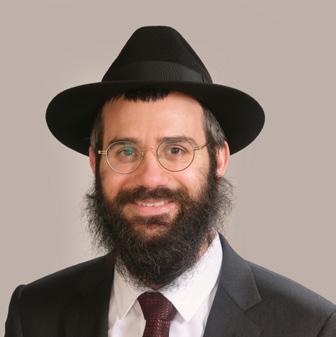 By Rabbi Sholom Ber Hendel, ~ Executive Kashrus Vaad
By Rabbi Sholom Ber Hendel, ~ Executive Kashrus Vaad
WHAT ARE POTATOES?
Potatoes are one of the major food crops grown around the world and are a staple in many homes, especially during Pesach. They are easily accessible, easy to store, affordable, and versatile. Potatoes can be prepared in numerous ways – boiled, roasted, or mashed as a hot side dish, processed into French fries or potato chips, or turned into flakes or starch. Potatoes are a raw material in many food products.
The potato is native to Peru and Bolivia. The Spanish introduced potatoes to Europe in the second half of the 16th century and, from there, spread all over the world. Today there are over two hundred different varieties of potatoes on the market. The average potato has only 110 calories and is a good source of vitamin C and potassium.
HOW ARE POTATO PRODUCTS PRODUCED?
STARCH
Raw potatoes are washed and ground, the proteins are removed, and the rest is centrifuged to separate and remove the fibers and remaining proteins. At this point, the water is removed in a vacuum filter and the product is then dried in a dryer resulting in a finished product which is a native starch that can be sold as is or modified with chemicals or enzymes to change the characteristics of the starch, to work better with the desired end products.
FLAKES
Potatoes are washed, steam-peeled, cut, and then blanched with hot water. The blanching deactivates the natural enzymes in the potatoes and improves the color, flavor, and texture as well as reducing the needed cooking time of the potatoes. The potatoes are then cooked with live steam, mashed, and mixed with additives, such as emulsifiers (processing aid for the drying process and to improve the
1. See Chelkas Binyamin YD 113:9.
texture), color, and preservatives. Finally, the mixture is dried on a hot drum that turns it into a sheet of dry potatoes, and then it is crushed into flakes and packaged.
FRENCH FRIES
The potatoes are washed, steamed, peeled (if required), cut to size, and then blanched in hot water. Colors and other additives can be sprayed on the product. The potatoes are then dried in a dryer. At this point, a batter might be applied to the product. Then the potatoes are fried, frozen, and packaged.
ARE PROCESSED POTATOES KOSHER? DO POTATOES REQUIRE BISHUL YISROEL?
The Shulchan Oruch (YD 113:1) states that there is a Rabbinic obligation that food should be cooked through a Jew if there are two conditions: 1. The food is not edible raw. 2. The cooked food is something that is “fit for a king's table”. In our days, the equivalent of a king's meal is a type of food that would be served at an important meal, such as a wedding.
Potatoes are not edible raw, so the question is if they are considered “fit for a king's table”. The Chochmas Adam writes that potatoes are considered “fit for a king's table”. However, the Oruch HaShulchan (YD 113:18) writes that potatoes are considered unfit for a king’s table since it is poor people's food and not an important food. He continues to say that it could be that in the time of the Chochmas Adam, potatoes were new to that part of the world and therefore considered to be a fancy food, but this is no longer the case.
The consensus today is that when potatoes are cooked in a way they could be served as a side dish at a wedding, they require bishul Yisroel because a food’s importance is judged based on the current practices.1
20 www.OK.org
A CLOSER
5
POTATO STARCH
Native starch is processed with kosher ingredients; however, it could potentially share equipment with wheat starch and should have kosher supervision for Pesach. Modified starch can be processed with enzymes and therefore always requires certification for year-round and Pesach.
POTATO FLAKES
Shulchan Oruch (YD 113:13) states that any food that is prepared through smoking is not considered cooking (for bishul akum). Some Poskim hold that the same applies to cooking with steam.
Rav Moshe Feinstein ruled that the concern of bishul akum does not apply to foods cooked in a factory, using equipment and processes that are entirely different to the regular cooking method in a home environment. When processing potato flakes, the potatoes are fully cooked before they are processed into potato flakes. The policy of all the major kashrus agencies is to allow the certification of the flakes without Bishul Yisroel based on the combination of both of the above opinions.2
The emulsifiers that are added into the flakes are kosher sensitive since they can be processed from vegetable oils or animal fat and therefore always require reliable certification.
FRENCH FRIES
The ~ requires Bishul Yisroel for French fries and potato chips if the heating source is not steam.3 The batter used on the French fries can contain nonkosher ingredients, such as cheese powders, which can compromise the kosher status of the equipment and the
2. See Minchas Yitzchok 3:26, 6.
3.
oil. In addition to making sure the new oil is kosher, the kashrus agency needs to make sure that the same oil was not used to process any dairy or non-kosher products. They also need to make sure that no used oil is transferred from a different processing line or even from a different manufacturing facility unless it is oil that is approved for kosher pareve production.
At food service establishments, French fries are usually prepared in deep fryers using the same oil as other products and therefore have the same kosher status. At a meat restaurant, the French fries are usually processed in the same fryers as other meat items. And in a dairy restaurant, they are usually fried using the same oil as other dairy products, such as cheese sticks.4 Needless to say, French fries coming from a non-kosher establishment are considered non-kosher.
KITNIYOS
The Chayei Adam5 ruled that potatoes are considered kitniyos because they can be processed into potato flour, which looks just like regular flour. However, this opinion was not accepted. The Pri Megadim6 writes that potatoes are not considered kitniyos. Rav Moshe Feinstein explains (Igros Moshe AC 3:63) that potatoes were not around when the kitniyos custom was established and was not added later because there was no strong reason to do so, and they were very needed. ~
4. A dedicated fryer or special arrangements need to be made in restaurants that have meat and fish fryers to make sure that no meat meal will be served with fries from the fish fryer or vice versa.
6.
www.KosherSpirit.com 21
This was a chumra held by Rabbi Don Yoel Levy, OB”M, Kashrus Administrator of the ~ from 1987-2020. The ~ continues to uphold this chumra.
.כ הלאש םדא תמשנ
א א"א ,ד"סת םייח חרוא
Matzah
Excerpted from At Our Rebbe’s Seder Table
“When one eats matzah, one eats G-dliness (the Rebbe Maharash, Rav Shmuel).”1
Our Sages state: “A child will not call out to his father before he tastes grain.” Eating matzah — “the bread of faith” — enables us to recognize our Father in Heaven (the Mitteler Rebbe, Rav Dov Ber). 2
The word matzah can also mean “strife.” Freeing oneself from the egotism and self-concern symbolized by chametz involves struggle and inner strife (the Alter Rebbe, The Baal HaTanya, Rav Shneur Zalman). 3

The Zohar two names: “the food of faith,” and “the food of healing.” For matzah strengthens our awareness of G-d. In general, eating strengthens the connection between the body and the soul. When one eats matzah, one internalizes a connection to G-d which transcends intellect, enabling the simple faith we all possess to permeate our lives. And this becomes “the food of healing,” strengthening the body and enabling it to appreciate the purpose for the soul’s descent (the Previous Rebbe, Rav Yosef Yitzchok Schneersohn).5
The Alter Rebbe taught: “On the first night, matzah is ‘the food of faith’; on the second night, ‘the food of healing.’” The Mitteler Rebbe explained that the opposite order, healing before faith, would imply that one was sick, and is giving thanks to Hashem for being healed. When, by contrast, faith comes before healing, one will never become sick.
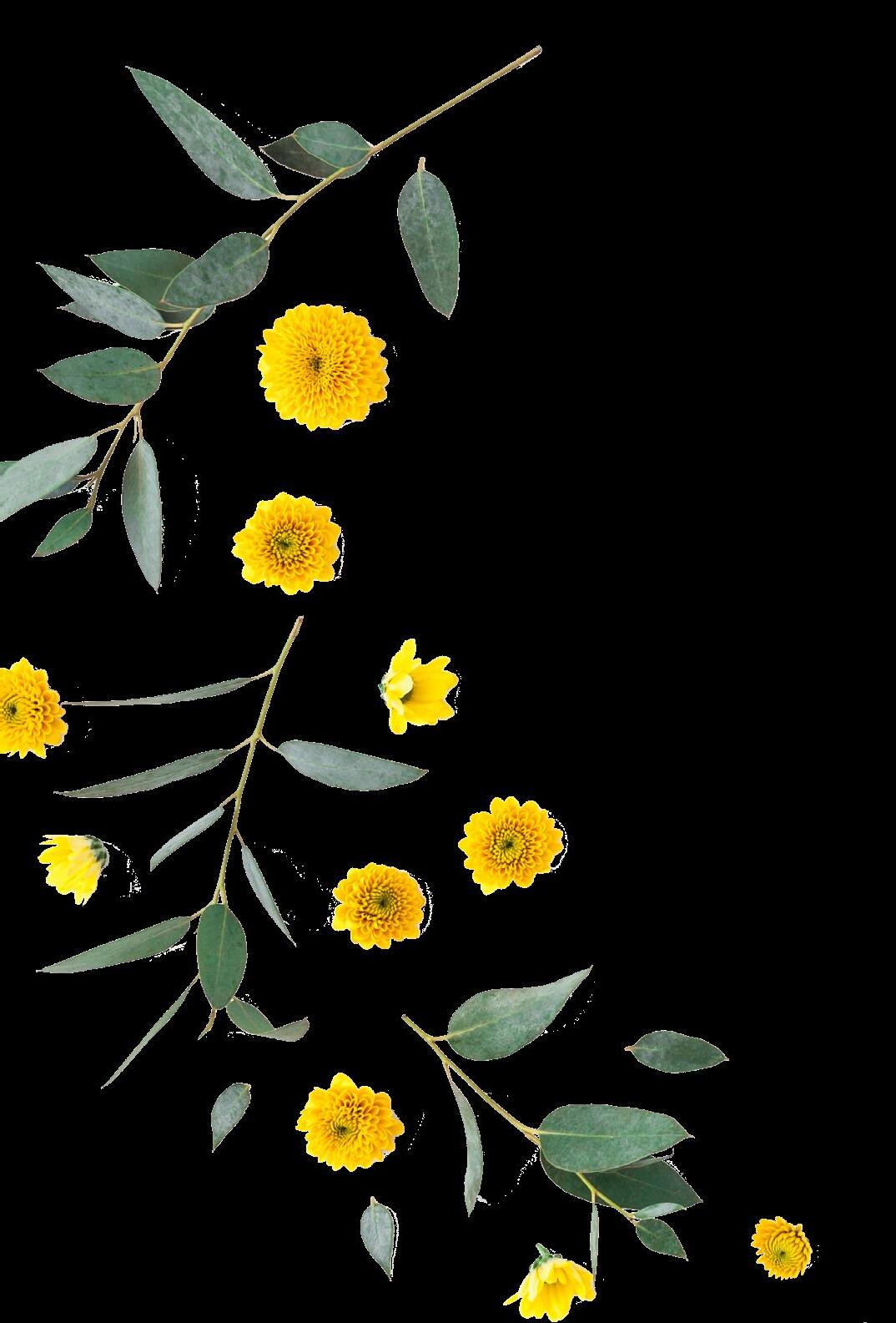
The Mitteler Rebbe added: “This applies in material things as well as in spiritual things. For a Jew, there is no division between the spiritual and the material (the Previous Rebbe, Rav Yosef Yitzchok Schneersohn).”6
The matzah of the Alter Rebbe would serve as “the food of healing” in the most literal sense. One of his Chassidim was a doctor in Riga. Each year, the Alter Rebbe would send him the remnants of the third matzah, the

maror, and the karpas from his Seder plate, and the doctor would crush them together and use them as medication.
Once he was called to tend to a patient with serious heart and lung disorders. Seeing no other remedy, he gave him the Alter Rebbe’s Pesach remnants. Miraculously, the patient recovered.
Another doctor who had cared for the patient was stunned by his recovery and asked the Chassidic doctor his secret. With genuine humility, the Chassidic doctor explained that the patient’s recovery was not a result of his own wisdom and told his colleague the ingredients contained in the remedy he had administered.
The other doctor had connections with prominent government officials. When the Alter Rebbe was imprisoned for spreading Chassidus , this doctor offered a character reference (Ibid.). 7
The content in this page is produced by Chabad. org, and is copyrighted by the author and/or Chabad.org. If you enjoyed this article, we encourage you to distribute it further, provided that you do not revise any part of it, and you include this note, credit the author, and link to www.chabad. org. If you wish to republish this article in a periodical, book, or website, please email permissions@chabad.org.
1. Hemshech VeKochah 5637, end of ch. 60.
2. Shaar HaEmunah, p. 17.
3. Likkutei Torah, Shir HaShirim, p. 14d.
4. II, 183b.
5. Sefer HaMaamarim 5709, p. 142-143.
6. Sefer HaSichos 5702, ps. 94-95.
7. Sefer HaSichos 5702, p. 91.
CHASSIDIC INSIGHTS
22 www.OK.org
By Rabbi Chaim Fogelman, ~ Executive Kashrus Vaad
Out of all 613 mitzvos in the Torah, only the mitzvah of Pesach has a second opportunity if one was unable to bring the Korban Pesach, either due to impurity or distance. Why is this the only mitzvah where Hashem gave us a second chance? The Jews complained, “Loma nigora? Why should we be left out?” Hashem responded to their cries by giving us a second chance, Pesach Sheini. What is so special about Pesach?
One of the central themes of Pesach is chinuch. It is all about teaching our children and families, the children asking questions, and we even tailor our responses to every child individually according to his understanding. We know that the Korban Pesach can only be done in a group. Why might that be?
Perhaps, because it's all about chinuch. Hashem gave us Pesach Sheini to remind us that there are always second chances, especially regarding chinuch. No, it’s never too late, and the lesson is twofold:
1. A child needs to know that if he misses out, or is unsuccessful the first time, there is always a second chance.
2. And, to the teacher or parent who might feel like he failed with his children or pupils in the past, it is never too late to try again.

Our Chachamim tell us that one of the proofs for techiyas hameisim is Az Yashir, the Song at the Sea. Rav Aharon of Belz, ztz”l, explained:
When the Jews left Mitzrayim, only a fifth of B’nai Yisroel were freed. Some even say only one in five hundred were left to leave Mitzrayim (the rest perished during the plague of darkness). Just imagine how broken Moshe Rabbeinu and many Jews felt after so many Jews passed away and so many loved ones were gone.
But they pulled themselves together and after crossing right through the middle of the sea they sang and praised Hashem because they believed their loved ones would return and would be reunited with them when Moshiach comes. For a grieving nation to show such Emunah is proof that we will survive, proof that there will be techiyas hameisim, and proof that Moshiach will come.
Today we are once again broken-hearted, both by the situation in Israel and anti-Semitism in every corner of the world. This is the time to remember that Moshiach will soon arrive, and all our troubles will disappear. This is the time to sing Hashem’s praises and to strengthen our steadfast Emunah and Bitachon that soon we will sing a song of freedom and redemption from this long dark exile.
www.KosherSpirit.com 23
SOUL NUTRITION
Is it Kosher for Pesach?
”Kosher Investigator beautifully captures Rabbi Berel Levy’s remarkable contributions to kosher food – and, more generally, to Judaism. A skilled investigator himself, author Dovid Zakilowski draws on oral interviews, obscure printed sources, and Rabbi Levy’s previously unknown personal papers to provide a revelatory account of his life. Written with great sympathy – and not shying away from controversial topics – this carefully researched book is a page-turner that readers will thoroughly enjoy.”
—Dr. Roger Horowitz author of Kosher USA: How Coke became kosher and other tales of modern food.

”Kosher Investigator pays honor to a founding father of modern industrial kosher certification. Rabbi Berel Levy’s passionate commitment to yiddishkeit and his keen powers of investigation helped transform the American kosher certification system into a model of reliable private regulation. Dovid Zaklikowski’s inspiring account also reveals the love of Torah and Am Yisroel that motivated Rabbi Levy’s many achievements.“
—Professor Timothy D. Lytton author of Kosher: Private Regulation in the Age of Industrial Food
Download the Kosher Food Guide app and get the most updated list of the Kosher for Passover Products that ~ certifies.

718-756-7500 • info@ok.org • www.ok.org
Spirit, 391 Troy Avenue • Brooklyn, NY 11213
Spirit, 391 Troy Avenue • Brooklyn, NY 11213 718-756-7500 • info@ok.org • www.ok.org
KOSHER CERTIFICATION ~ Kosher
Coming Soon November 2017! KOSHER CERTIFICATION ~ Kosher
Search“OK Kosher” ontheAppStore& GooglePlaytofind our apps








 By Rabbi Sholom Ber Lepkivker ~ Rabbinic Coordinator
By Rabbi Sholom Ber Lepkivker ~ Rabbinic Coordinator






























 By Rabbi Sholom Kesselman, ~ West Coast Food Service Coordinator
By Rabbi Sholom Kesselman, ~ West Coast Food Service Coordinator





















 By Rabbi Sholom Ber Hendel, ~ Executive Kashrus Vaad
By Rabbi Sholom Ber Hendel, ~ Executive Kashrus Vaad





